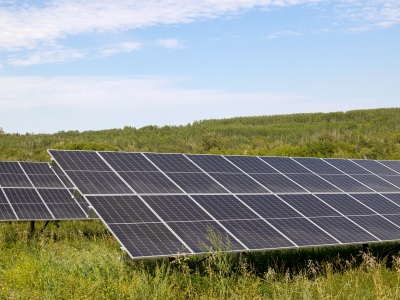
EPCOR Utilities Inc., an Edmonton-based energy company, has opened a solar farm in the Edmonton River Valley to provide clean energy for a critical water treatment plant and lead the company’s net-zero aspirations.
The solar farm is named ‘kīsikāw pīsim,’ or “daylight sun” in the Cree language. It was named by the Enoch Cree Nation, whose territory the solar farm is situated on.
It will power the E.L. Smith Water Treatment Plant. The plant, which provides 65 per cent of water to the Edmonton region, once relied purely on grid power. But kīsikāw pīsim will now provide approximately half of the power the E.L. Smith water treatment plant needs on an annual basis.
The kīsikāw pīsim solar farm
EPCOR operates in the energy, natural gas, water and wastewater treatment fields and has Canadian operations in Alberta, B.C., Ontario and Saskatchewan. It also serves U.S. clients in New Mexico, Texas and Arizona.
The 13.6 MW solar farm was built for approximately $40 million and will produce about 21,500 mW-h in first year. It has the distinction of being Canada’s largest smart grid, according to Trina Manning, senior manager of sustainability for EPCOR.
As a smart grid solar farm, it is connected to an electricity meter that is adjacent to the water treatment plant. It will directly power the plant via 30,350 solar panels or store energy on a 4 MW lithium-ion battery that is comprised of 1008 batteries.
The battery will power the facility when the sun is not visible and will provide power on moments of high demand to reduce reliance on the grid. If there is excess energy production, it can direct energy to the grid.
The battery, called the Battery Energy Storage System (BESS), was funded with a $10.7 million grant from Natural Resources Canada.
“We have essentially a lot of different components on our site so we can optimize the electricity here, and provide some resiliency for the water treatment plant,” Manning said.
“(We are) hoping this is a great opportunity for other utilities, other municipalities to look at the option and learn from this opportunity and take that learning to develop more storage capacity in other ways and other sites as well,” she added.
Kīsikāw pīsim is expected to offset around 14,000 tonnes of carbon dioxide equivalent (tCO2e) per year. Manning said the figure could change as Alberta’s grid factor adapts to increasing clean energy adoption.
Indigenous reconciliation and preserving biodiversity
The solar farm is part of the reconciliation journey for EPCOR. The E.L. Smith treatment plant is built on Enoch Cree Nation land. When EPCOR engaged the Enoch Cree Nation to build the solar farm, it became part of the project to recognize the Nation’s connection to the land, Manning said.
The company started by listening to concerns of the Enoch Cree Nation in public hearings with the city of Edmonton for rezoning changes. It formed a memorandum of understanding and identified reconciliation opportunities like returning ceremonies to the land and allowing future use like the harvest of gooseberries and Saskatoon berries.
There were also procurement opportunities for Indigenous businesses during kīsikāw pīsim’s construction. It allowed for construction companies connected to the Enoch Cree Nation to be hired, and Indigenous monitors were present to observe the work.
To promote and protect biodiversity, EPCOR chose to support local vegetation to help pollinators like bees and wasps, and increased the tree and shrub area adjacent to the solar farm for wildlife connectivity.
“We wanted to end up with a net-gain in the vegetation around the area,” Manning said. The Enoch Cree Nation requested gooseberry and Saskatoon berry shrubs specifically, she said.
EPCOR’s net-zero plans
The solar project falls into EPCOR’s net-zero blueprint as one of its largest clean energy projects. More than 75 per cent of EPCOR’s greenhouse gas (GHG) emissions are from Scope 2 emissions related to electricity consumption to pump drinking water through a treatment process, according to the EPCOR website.
EPCOR says it aims to achieve net-zero GHG emissions by 2050 for Scope 1 and 2 emissions, with a 50 per cent reduction by 2025. Manning said EPCOR is on track to reaching its 2025 goal, and the solar farm is “part of that pathway."
The solar farm and a wind power resource in Hilda, Alta. are the two notable projects the company names as part of its strategy. The two projects are expected to reduce its net emissions by more than 95,000 tCO2e per year.
“(Like) any net-zero roadmap, there’s so many things that we’re gonna have to do. So the solar farm is one component. Within the City of Edmonton (we’re) really wanting to see more of a catalyst for further action . . . There is an urgent need to take action and also to show leadership in this area so we’re really a unique project to demonstrate EPCOR’s leadership and help others that are also on that path and journey with us.”
Manning said EPCOR is looking at the geographies it is working in, specifically noting Edmonton, Arizona, New Mexico and Texas. She said it is an ongoing discussion to create a pathway to net-zero that will require initiative across its geography.
Its next ESG report due in May 2023 will provide an update on its net-zero goal. It will include its work around electric vehicles, electric vehicle charging stations and grid transformation in Edmonton.










